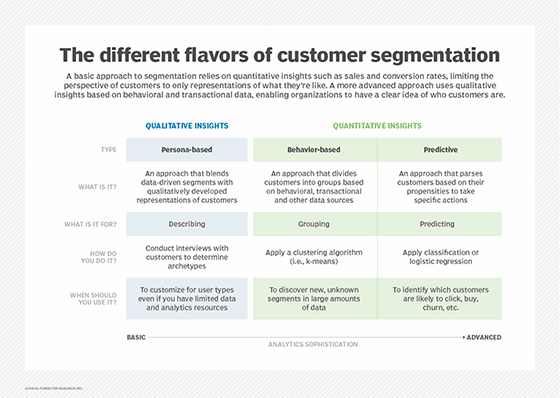Review the Five Customer Segments Detailed on Page 194 195 of Your Textbook
Client partitioning is the practice of dividing a customer base into groups of individuals that are like in specific ways relevant to marketing, such as age, gender, interests and spending habits.
Companies employing customer partitioning operate nether the fact that every customer is different and that their marketing efforts would exist ameliorate served if they target specific, smaller groups with messages that those consumers would find relevant and lead them to buy something. Companies besides hope to proceeds a deeper understanding of their customers' preferences and needs with the idea of discovering what each segment finds most valuable to more accurately tailor marketing materials toward that segment.
Customer sectionalization relies on identifying key differentiators that divide customers into groups that can exist targeted. Data such as a customers' demographics (age, race, faith, gender, family size, ethnicity, income, education level), geography (where they live and work), psychographic (social class, lifestyle and personality characteristics) and behavioral (spending, consumption, usage and desired benefits) tendencies are taken into account when determining customer sectionalisation practices.
Customer sectionalisation procedures
Customer sectionalization, also called consumer segmentation or client segmentation, procedures include:
- Deciding what data will be collected and how it will be gathered
- Collecting data and integrating information from various sources
- Developing methods of information analysis for segmentation
- Establishing effective advice among relevant business organization units (such every bit marketing and customer service) almost the sectionalization
- Implementing applications to effectively bargain with the data and respond to the data it provides
Benefits of client segmentation
By enabling companies to target specific groups of customers, a client segmentation model allows for the effective allocation of marketing resources and the maximization of cantankerous- and upwardly-selling opportunities. When a grouping of customers is sent personalized messages as part of a marketing mix that is designed around their needs, it'south easier for companies to send those customers special offers meant to encourage them to buy more than products. Customer segmentation tin also meliorate customer service and assist in customer loyalty and retentivity. As a by-production of its personalized nature, marketing materials sent out using customer segmentation tend to be more than valued and appreciated by the customer who receives them every bit opposed to impersonal brand messaging that doesn't acknowledge buy history or any kind of client human relationship.
Other benefits of customer partitioning include staying a stride ahead of competitors in specific sections of the marketplace and identifying new products that existing or potential customers could exist interested in or improving products to encounter customer expectations.

Importance of customer segmentation
Not simply exercise companies strive to divide their customers into measurable segments according to their needs, behaviors or demographics just they also aim to decide the profit potential of each segment by analyzing its revenue and cost impacts. Value-based segmentation evaluates groups of customers in terms of the acquirement they generate and the costs of establishing and maintaining relationships with them. Information technology also helps companies make up one's mind which segments are the about and least profitable then that they tin accommodate their marketing budgets appropriately.
Customer partitioning tin have a bang-up effect on customer management in that, by dividing customers into unlike groups that share like needs, the company tin can market to each group differently and focus on what each kind of customer needs at any given moment. Large or small, niche customer segments tin be targeted depending on the visitor's resources or needs.
In B2B marketing, companies are concerned with determination-makers' task titles, the manufacture sector, whether the company is public or private, its size, location, ownership patterns and their technology at their disposal, for example.
In B2C marketing, companies are concerned with particular customers' profiles, attitudes and lifestyles. B2C companies may besides be concerned with geographic location. B2C companies who segment customers based on their geographic location can tailor offers based on regional events and preferences. B2C companies tin also customize offers based on the predominant languages spoken in each region.
Approaches to B2B client sectionalization include vertical or horizontal alignments. In vertical segmentation, companies select certain industries or job titles that would likely find their products appealing and and then focus marketing efforts on those segments that they feel are most set up to buy. The benefit of vertical partition is that companies tin can offer services that are fine-tuned to particular industries. The needs of the fiscal services industry are different from those of the healthcare industry. If each segment was offered services customized to that industry, adoption and satisfaction might increase.
In horizontal segmentation, companies simply focus on one job title across a wide range of industries and organizations. The benefit of horizontal segmentation is a stronger focus on the needs of item job titles or job roles. For example, a focus on Master Fiscal Officers (CFO) can create product collateral, website messaging and e-mail newsletters specifically tailored to that role.
Client segmentation vs. market segmentation
Companies tin can use marketing automation software to define and create customer segments. The customer segments can be based on demographic data, psychographic data and activeness-based data such as actions that users took on a website. Companies utilize marketing automation software to configure, schedule and execute campaigns for particular customer segments.
Customer partition is different from market place division. An case of market segmentation is grouping customers past the products or services they purchase. A visitor may perform market segmentation based on distinct lines of business such every bit software, professional services and training. The visitor can then classify resources to each market segment and utilize carve up marketing and advertisement activities to each.
This was last updated in April 2019
Continue Reading About customer segmentation
- Understand client sectionalisation in the telecom sector
- 9 strategies for email marketing sectionalisation
- Ameliorate customer retentivity with an effective partitioning strategy
- Customer information plus alternative data equals statistical success
- 3 Customer Segmentation Models Every Marketer Should Consider
Dig Deeper on Customer data management
-

Avant-garde upselling tactics, technologies expand lesser line
-

Adobe CDP adds B2B-friendly features
-

CDP vs. marketing automation: What'south the divergence?
-

9 strategies for email marketing partition
mackellarwileved78.blogspot.com
Source: https://www.techtarget.com/searchcustomerexperience/definition/customer-segmentation




0 Response to "Review the Five Customer Segments Detailed on Page 194 195 of Your Textbook"
Post a Comment